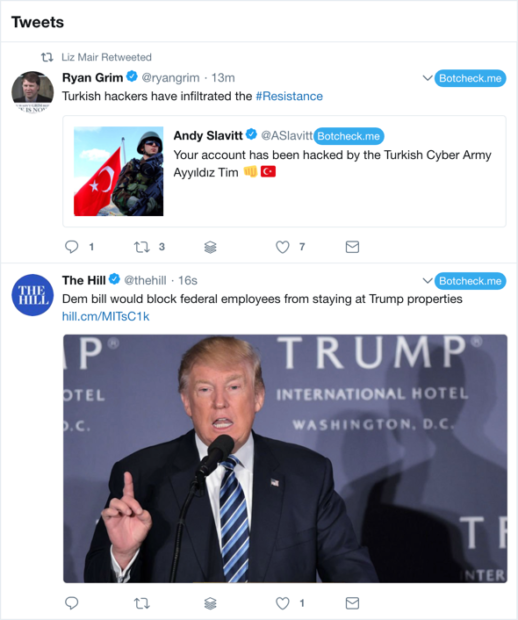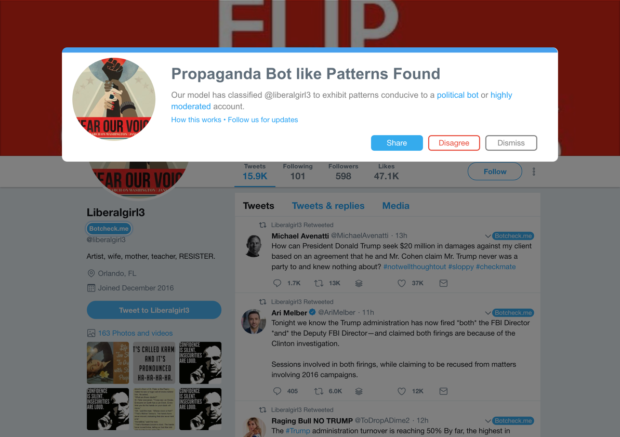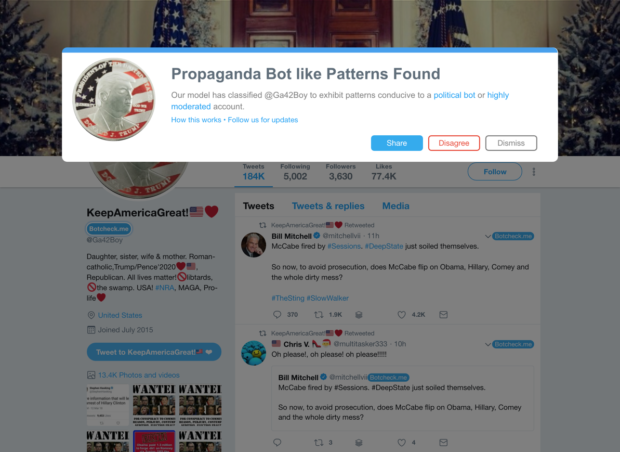There are two ways a political campaign can get itself into Twitter trouble. The first is to tweet something troublesome. Avoiding that kind of strife requires a whole series of blog posts. But the second way to get yourself in a Twitter mess is to retweet something troublesome. Constituents interpret this as an endorsement of the ideas or information contained in the Tweet. Your political campaign essentially takes part ownership.
What’s the definition of troublesome? That’s in the eye of the beholder. Obviously, if the Tweet espouses a particular policy position or ideology, people on the other side will take issue. But another category of trouble includes unwittingly propagating fake news.
Fake News and Twitter Bots
This is a risky topic to discuss (it’s probably worth repeating that Candidate Boot Camp is non-partisan). The “fake news” label has been used by both major political parties as a weapon to delegitimize the other. Another challenge is that the term itself can mean different things to different people. Here’s how Wikipedia defines it:
Fake news is a type of yellow journalism or propaganda that consists of deliberate misinformation or hoaxes spread via traditional print and broadcast news media or online social media. Fake news is written and published with the intent to mislead in order to damage an agency, entity, or person, and/or gain financially or politically, often using sensationalist, dishonest, or outright fabricated headlines to increase readership, online sharing, and Internet click revenue. In the latter case, it is similar to sensational online “clickbait” headlines and relies on advertising revenue generated from this activity, regardless of the veracity of the published stories. Intentionally misleading and deceptive fake news is different from obvious satire or parody, which is intended to amuse rather than mislead its audience.
That’s close enough for the purposes of our discussion. Being associated with fake news can damage the credibility of your political campaign. Twitter has long been (and continues to be) on the vanguard of many social media trends and unfortunately, fake news is no exception. Twitter’s strength is also its greatest vulnerability. When you are in the business of creating information firehoses, things happen so quickly it can be hard to detect problems before the place is flooded.
For those reasons, Twitter is a prime target for “bots,” which is a term for software tasks that run automated tasks over the Internet. These bots perform tasks that can quickly and efficiently scale an account’s ability to expand its audience and disseminate messages. Bots are a means for groups — legitimate or otherwise — to spread information quickly and efficiently across the web.
I highly recommend you take 9 minutes to watch Sharyl Attkisson provide some background and useful strategies from her book The Smear: How Shady Political Operatives and Fake News Control What You See, What You Think, and How You Vote.
How to Spot a Bot on Twitter
I’ve been on Twitter for nearly ten years. Believe it or not, it was a comparatively small community back in those early days. Sixteen thousand Tweets later, I can typically rely on my intuition to spot fake accounts with a reasonable degree of accuracy. Now, there’s a new browser extension called Botcheck.me that can help. It’s an app written by two college students, Ash Bhat and Rohan Phadte, the founders of RoBhat Labs.
An article in Wired magazine explains:
On Twitter, it’s hard to sort out propaganda bot accounts—seemingly ordinary users or organizations that are actually automated by software—from real people using the website. Unlike Facebook, which requires various proofs of real personhood to get a profile, Twitter only requires a phone number to start an account. It also allows outside users to access its platform’s data, which can be used to automate accounts for legitimate purposes, or be gamed for non-legitimate ones. Silicon Valley is only beginning to reckon with the proliferation of people trying to unhinge democracy by digital means. On Twitter, that looks like networks of bots propagating fake news, dragging the level of political discussion into the sewer, and creating the illusion of widespread movements where there is none.
The two developed a machine learning algorithm that they claim can identify automated accounts with 93.5% accuracy. Installing the browser extension adds a handy button next to Twitter handles in your feed:
Clicking the Botcheck.me button will open a window that tells you whether or not the account displays Bot-like patterns.
Until now, discerning fake Twitter accounts from real ones was all art and no science. Botcheck.me changes that and can help your policial campaign steer clear of them.
Don’t Neglect the Fundamentals
Unwittingly associating your political campaign with fake news is just one of many social media mistakes. For a list of others, check out our article that lists 14 Social Media Mistakes to Avoid In Your Political Campaign as well as 7 Facebook Advertising Mistakes Political Candidates Make.
Image Credits
The fin de siècle newspaper proprietor by Frederick Burr Opper via Wikimedia Commons.
IFLA infographic based on FactCheck.org’s 2016 article “How to Spot Fake News” in PDF format
Ash Bhat and Rohan Phadte via Twitter






